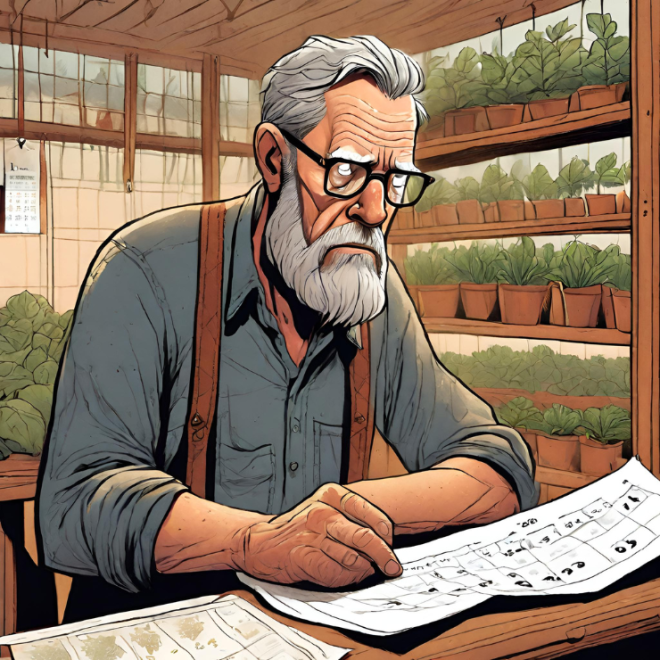Read by Michael Flamel


Warning: This story, like 90 percent of gardening, is a cliffhanger. Most of you will be familiar with that term, but in the interest of stalling for time, I will now explain.
Back in the day, “going to the movies” involved not only the feature picture, but a cartoon, a Newsreel and a short subject beforehand. Maybe you also got a physical object, like a dish as a gift (“Come back every week and compile a complete set!” [if you don’t break them on the way home]).
In some cases, mostly Saturday matinees, there wasn’t a Newsreel, but you did get a “serial” or “chapter play.” Over the course of 12 or 15 weeks, a tale would unfold until its conclusion in the final chapter. Previous to that conclusion, each episode would end with our hero (Batman, Captain Marvel, Zorro, Jungle Jim, etc.) facing certain death. The car they were driving would go off a cliff; they would appear to be fatally shot or stabbed; trapped in a room with poison gas; or more specifically to the name, on the wrong side of a cliff hanging on to a sapling that you watched slowly pull out of the ground.
A loud gong would then proclaim something like “Could this be the end of The Batman? Be sure to visit this theater next week for Chapter Seven, ‘Robin Flies Alone!’”
Of course, Chapter Seven reveals that the heroes had gas masks hidden in their socks, had jumped out of the car with seconds to spare, or rolled down the hill until they landed on their feet at the bottom flinging their capes behind them. It was corny; it was campy; but you had to keep going back to see how they got out of it.
I hope that my own personal thriller starring the mysterious gourd known as loofa (or loofah) is a fifteen-chapter serial, because if it’s only a twelve-week version, I’ll be loofa out of luck.
Back when I first started gardening (at a rental home where I was permitted the use of a thousand-square-foot area IN FULL SUN (cue Angelic chorus)), I grew everything: Sweet corn! Pumpkins! Lots of peppers, tomatoes and eggplant, of course, and also loofa gourds. I bought my starts at a mysterious little nursery alongside the Delaware River in a very old area of Pennsylvania.
They had everything plus. One year I grew my own sesame; one year it was upside-down bell peppers; and one year it was ‘bath sponge gourds.’ “You can grow your own sponges from these!” assured the wizened owner—and I did!
The vines covered the garden like a swarm of army ants, produced big yellow flowers that the bees LOVED, and eventually bore ‘fruits’ that looked like an inflatable medical device from the 1930s or a tiny zeppelin that needed more inflation. I let them turn brown and dry as instructed, peeled back the old-leather-football-like cover, and there were sponges inside! Success!
(Everything in my first few years of gardening at that site was a success. Little did I realize that Nature would soon bring out her “special” dice and watch me roll myself into one abject failure after another.)
This year I was offered a pack of loofa seeds by Renee Shepherd and announced to my listeners that I would once again grow loofas. “Like pumpkins, loofas are true gourds (“All pumpkins are gourds, but not all gourds are pumpkins.”) and they are one of the best ‘novelty crops’ you can grow,” I proclaimed, “harvesting an all-natural bath sponge from each gourd—if you do it right.”
The Big Issue, I explained, is Timing. Loofas take a long time to fully mature. My Renee’s Garden seed packet specifies a maturity rate of 110 days, which is a long time, especially if it means what I suspect.
To explain that comment, we must now delve into the murky mists of DTM (Days to Maturity). For crops that are typically started indoors and then transplanted outdoors when they are six to eight weeks old (like peppers and tomatoes), the DTM clock doesn’t start ticking until the transplant goes in the ground.
But for crops that are typically direct seeded, like corn, peas, beans, salad greens, and such, DTM refers to the date the seed was planted (in warm soil, of course). Most of us have to start our loofas indoors to get enough growing time, so add six weeks to 110 days and you come up with 150 or so days to sponge harvesting.
I’m in a medium-level USDA Zone 6. You shouldn’t plant tropicals and semi-tropicals like gourds, tomatoes, and peppers until nighttime temps are reliably in the fifties. This May stayed chilly. (Apparently global warming is like a cop; never around when you want one.) But I still had all of June, July, and August for prime-time growing. Which meant September would tell the tale; a warm September, and I’d have a shot at achieving fully matured gourds. (And yes; fully matured they must be for this to work, sponge-wise.)
(The task is a lot easier for gardeners in USDA Zone 7 and above. But if you’re in a low, colder zone, the odds are against you. Not saying it can’t be done, but it requires a lot of strategizing on your end.)
To add to the excitement, growing my own loofas this year reminded me that they grow like pumpkins, which is to say all over the place. If you have grown pumpkins, you know that their vines are the 800-pound gorillas of the garden. They grow wherever they want, smothering puny pepper plants like Godzilla trampling a car wash to clean his toenails.
Seemingly overnight, my two loofa starts engulfed all the other plants. It took hours to untangle this puzzle, and at least one pepper plant joined the Choir Invisible during the surgery.
I decided to move the loofas to a giant raised bed on legs right outside my front door, where they would be somewhat protected from chilly nights. The two vines proceeded to run a marathon over the entire front of the house, reaching the roof line in record time. It took a while for the first female flowers to show up, but they did, and I finally had my first sponge-to-be growing. It looked like an alien cucumber, grew fast, then was followed by two more.
At this point, we started pulling off any new flowers to force energy into ripening the existing fruit faster. As with all squash blossoms, the flowers are edible, and a delicacy when stuffed with a soft herbal cheese. (My Martha Stewart moment for ya’ll.) I have also been advised that the young fruits are edible when picked small and eaten like zucchini. Thanks, but I don’t eat things that look more like lawn darts than Summer squash.
Now we’re in the home stretch. It is October 15th as I pound these words into my helpless keyboard; we are still frost-free and all three baby zeppelins are fully sized, but still green. Ideally, you want to wait until the fruits turn brown to harvest. (If you hear seeds rattling around inside, congratulations; you’re definitely the proud parent of your own home-grown exfoliators!)
I am determined that, whatever happens, I’ll bring them inside before the first hard freeze and let the gourds air out to dry and maybe get a little riper (hey; pumpkins do!). Then I’ll peel off the (hopefully formed) outer brown shell, preferably using my fingers to rip off portions. Then I’ll rinse the sponge that (again, hopefully!) awaits inside and set it aside to dry.
If you’re using this story as future gardening inspiration: 1.) Remember who your instructor is; and 2.) Don’t try this in USDA Zone 4.
Anyway, you can use the sponge whole or slice it up into smaller sections to be filled with liquid soap. Either way, the result is well worth the wait, as these are THE best bath and shower sponges. Oh, and we never bleach ours to whiten up the color, as some sources suggest. Naturally light brown is just fine with us.
As we close for today, the gourds are big and green, but with no sign of brown. No frost in the forecast, but the hours of daylight are getting dramatically shorter and the nights noticeably cooler. It’s a race against time! Will I jump out of the car in time? Or discover too late that I left my gas mask in my other cape?
You’ll learn the pulse-pounding answer when you thrill to Chapter 11: “Loofas or Losers?” at the theater next week.
Maybe we’ll give you a dish … ❖


 Previous
Previous



Zone 7…tried growing “exfoliators” but not successful.
I’m old enough to remember “China” coming in soap boxes and when we went to the Saturday morning matinees, we paid a dime or a quarter to see Gene Autry and Champion the Wonder Horse. Loved the article and your taxing “personaliky, kee, kee, kee” says Popeye The Sailor Man! Keep ’em coming, Mike, they do add a jump start to an old lady’s day!
This is a funny story. I enjoyed it. My Mother would buy boxes of breeze laundry soap for the free bath towel that was inside. I’v always wondered how those sponges grew. Sounds fun growing them. Thanks, I’ll tune in for next week.